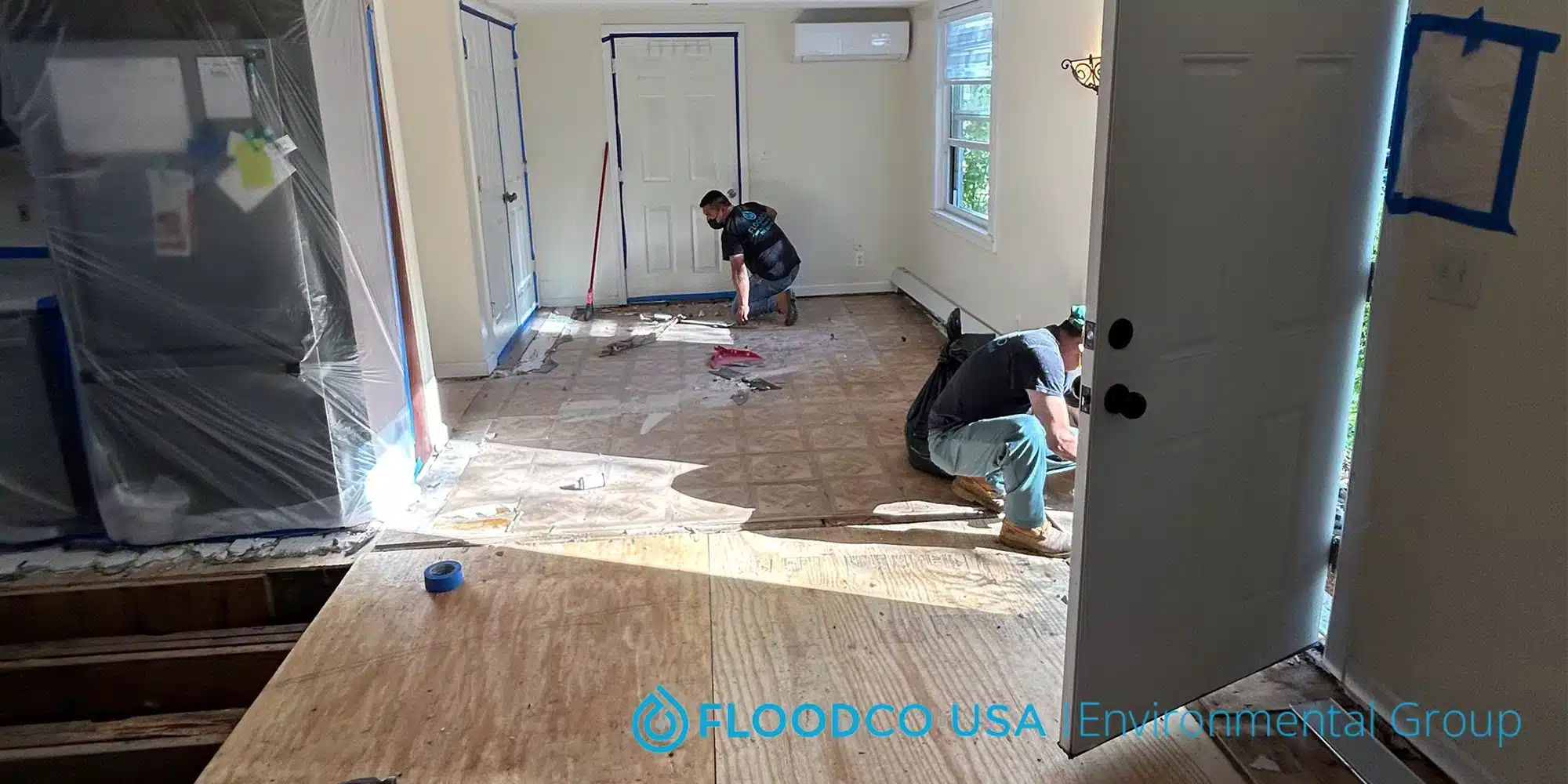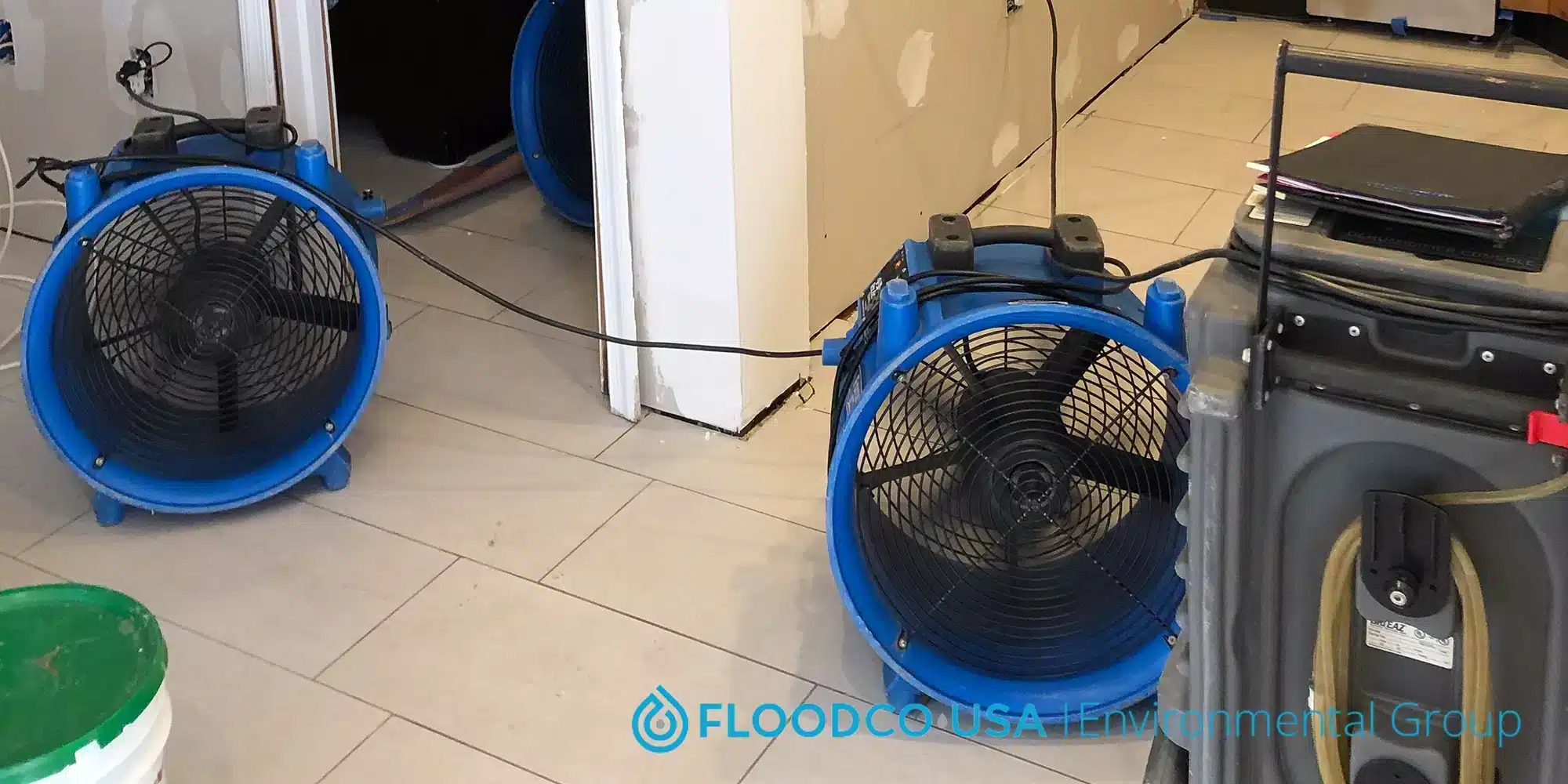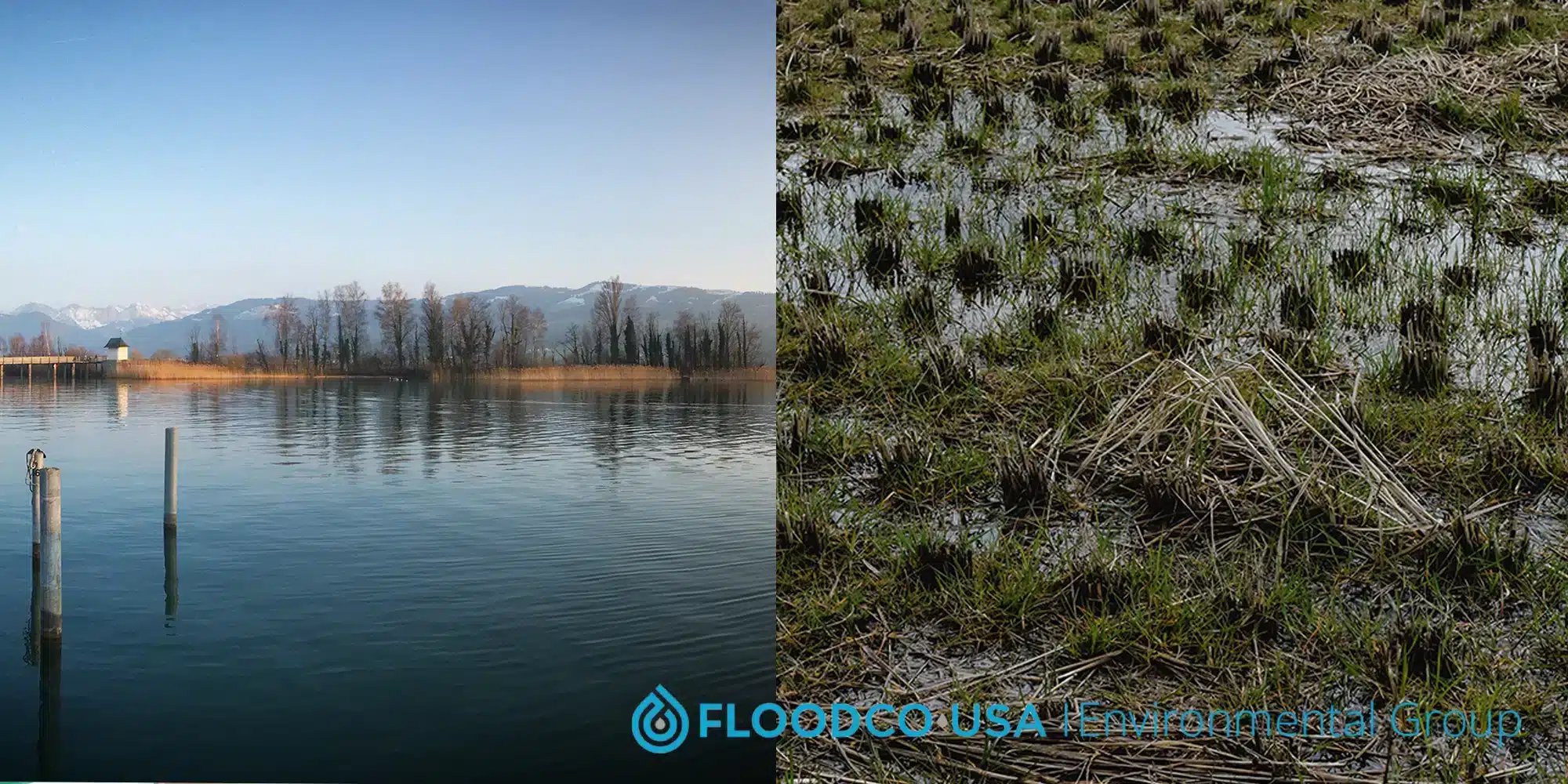Flood Cleanup Guide: Understanding & Mitigating Damage

Flood cleanup is critical to disaster recovery, demanding a strategic and informed approach. This guide offers a professional flood damage analysis, addressing its causes, consequences, and environmental implications. It is an essential resource for specialists and practitioners in the field, providing insights and methodologies for effective flood restoration and mitigation. Our Water Damage Restoration experts are here to help.
Flood Restoration: Causes of Flood Damage
Flood restoration often becomes necessary due to a range of natural causes, such as heavy rainfall, hurricanes, and melting snow, which can lead to rivers overflowing their banks and inundating the surrounding areas. Human-induced causes include poor land management, deforestation, and inadequate urban planning, which can exacerbate the severity and frequency of floods by reducing natural water absorption and altering water flow patterns.

Natural Causes
One primary cause of flood damage is heavy rainfall and severe storms, often linked to flash floods. These intense weather events can lead to rapid indoor flooding and home flooding, resulting in substantial property damage and flood damage.
Additionally, other natural factors contributing to flood damage include snowmelt, ice jams, hurricanes, and tropical storms. While the average damage caused by these natural disasters can vary widely, it’s essential to note that severe flooding from hurricanes and tropical storms can lead to the most extensive and devastating flood damage scenarios.
Human-Induced Causes
On the other hand, human-induced causes like urbanization and poor drainage systems can exacerbate the effects of floods. In urban areas, drainage systems may not be equipped to handle the volume of water from heavy rainfall, leading to severe consequences.
Dam failures, often the result of aging infrastructure, can result in major damage to downstream communities. These types of human-induced causes can significantly contribute to the overall flood damage, especially in areas with a high population density.
When assessing the average damage caused by floods, it’s crucial to consider various factors, including the type and scale of the flood. While heavy rainfall and severe storms can lead to substantial property damage, it’s the severe flooding associated with hurricanes and tropical storms that tends to cause the most extensive and devastating flood damage. Understanding these causes is essential for implementing effective flooding repair and after flood cleanup strategies.
Understanding Indoor House Flood and Its Effects

Indoor house floods, often resulting from issues like pipe bursts or natural disasters, lead to significant property damage, including the deterioration of building structures and harm to critical infrastructure such as electrical and plumbing systems. This type of flooding not only entails substantial economic consequences due to the high costs of repairs and restorations but also disrupts daily living and imposes long-term financial strains on affected individuals.
Property Damage
Property damage is the foremost concern when it comes to flood damage. Even as little as 1 inch of water from floodwaters can spell disaster for homes, wreaking havoc on floors, walls, and electrical systems. This seemingly modest amount of water can infiltrate every nook and cranny, causing severe harm. It’s essential to be prepared for such situations, especially during the winter months when the risk of flooding increases. To learn more about safeguarding your home from winter flooding, read our blog on How to Protect Your Home from Winter Flooding. The impact of flood damage goes beyond the immediate, visible destruction, often resulting in long-term consequences that can be substantial. Property owners frequently face the need for costly repairs and comprehensive flood damage cleanup and restoration efforts to restore their homes to their pre-flood condition.
Impact on Buildings
The damage doesn’t stop at personal property; it extends to the structures themselves. Floods can severely impact buildings, with structural damage being a common consequence. The sheer force of moving water can compromise a building’s foundation and walls, leading to potentially expensive flood restoration efforts. Moreover, the infiltration of floodwaters can introduce harmful contaminants, further weakening a structure’s stability. The toll on buildings goes beyond aesthetics, impacting their safety and functionality.
Damage to Critical Infrastructure
Beyond residential and commercial properties, floods also wreak havoc on critical infrastructure. Transportation routes, such as roads and bridges, are particularly vulnerable. Floodwaters can compromise the integrity of these vital components, causing bridges to become compromised and roads to be washed away. The result is a disruptive ripple effect that affects entire communities, hampering economic activities and the daily lives of residents.
Economic Consequences
The economic toll of flood damage is significant, encompassing expenses related to flood restoration, water cleanup, and flooding repair. These costs can place a heavy burden on communities and individuals alike. Recurrent indoor flooding, in particular, can lead to decreased property values, compounding the financial consequences of flood damage. The aftermath of a flood often requires substantial financial investments to restore property and infrastructure to pre-flood conditions.
Health and Safety Concerns
The damaging impact of floods extends to health and safety. Floodwaters are often contaminated with pollutants and bacteria, posing significant health risks to anyone who comes into contact with them. Proper flood water cleanup is essential to ensure the safety of residents. Additionally, mold and other structural hazards can persist long after the floodwaters have receded, making after flood cleanup a crucial step in safeguarding residents’ well-being.
Flood damage is a multifaceted challenge that affects property, buildings, critical infrastructure, and the overall well-being of communities. The damage is not limited to immediate, visible destruction; it encompasses long-term consequences that require significant resources and expertise for effective mitigation and recovery. Understanding the full scope of flood damage is essential in implementing comprehensive flood restoration and after flood cleanup strategies.
Environmental Impacts of Flooding

Flooding can have severe environmental impacts, including the spread of pollution and contamination of water sources, which can harm both human health and ecosystems. Additionally, it leads to the displacement of wildlife, disrupting natural habitats, and contributes to a feedback loop in climate change by altering landscapes and potentially releasing stored carbon.
Pollution and Contamination
One of the most alarming aspects of flooding is the pollution and contamination it introduces into ecosystems. Floodwaters can wash a wide range of contaminants, including chemicals and sewage, into water bodies. This poses a substantial threat to aquatic ecosystems and can severely hinder efforts for effective water cleanup. The presence of pollutants affects aquatic life and the quality of water resources, affecting the well-being of both flora and fauna. Furthermore, the long-term restoration of affected areas is often hampered by the lingering effects of contamination, making it a complex challenge for environmental experts to address.
Displacement of Wildlife
Floods have profound and often negative repercussions on wildlife and local ecosystems. The displacement of wildlife from their natural habitats is a significant concern during flood events. Such disruptions can result in a loss of biodiversity, affecting the delicate balance of ecosystems. As part of comprehensive environmental restoration efforts, measures are frequently taken to safeguard and rehabilitate these ecosystems. However, the destruction of habitats due to flood damage can have long-lasting consequences for wildlife populations. This may lead to shifts in species distribution, endanger vulnerable species, and cause ripple effects throughout entire ecosystems.
Climate Change Feedback
Another alarming facet of flooding is its contribution to climate change feedback loops. The increasing frequency and severity of floods are closely linked to climate change, forming a destructive feedback cycle. As global temperatures rise and weather patterns become increasingly unpredictable, extreme events like floods become more frequent and intense. Understanding this intricate connection is paramount for addressing the root causes of flood damage and implementing effective mitigation strategies. Floods, as a consequence of climate change, not only inflict direct damage to the environment but also contribute to the ongoing environmental crisis. This underscores the urgency of taking immediate action to reduce greenhouse gas emissions and adapt to a changing climate.
Floods have a profound impact on the environment, leading to pollution and contamination of water bodies, the displacement of wildlife and disruption of ecosystems, and their contribution to climate change feedback loops. Recognizing and comprehending these impacts is essential for developing and implementing effective environmental restoration and mitigation strategies in the face of increasing flood risks.
Comparing Flood Damage to Other Disasters
Flood damage cleanup often reveals that the severity and unpredictability of flood damage can surpass many other disasters, especially due to changing weather patterns leading to unexpected, large-scale indoor flooding. Understanding the variability of flood damage is crucial, and for those affected, contacting our company for prompt and efficient restoration services is a vital step towards recovery and safety.
The Severity of Flood Damage
When assessing the extent of damage caused by natural disasters, the question often arises: Do floods cause the most damage when compared to other calamities like earthquakes and wildfires? To gain a comprehensive understanding of flood damage, it’s essential to explore the facts about flood damage and its relative impact when pitted against these other formidable disasters.
Unpredictability of Weather Patterns
Floods are undeniably among the most destructive natural disasters, and their severity is frequently underestimated. To truly grasp the gravity of flood damage, it’s important to consider several key factors distinguishing floods from other disasters. First and foremost is the unpredictability of weather patterns, which is pivotal in rendering floods so devastating. Unlike earthquakes that strike suddenly and wildfires that rapidly spread, floods often result from a combination of weather events, making it challenging to predict their timing and extent. You can stay updated on weather forecasts and patterns through the National Weather Service website.
Potential for Large-Scale Indoor Flooding
Another critical factor that contributes to the destructive nature of floods is their potential for large-scale indoor flooding. Unlike earthquakes, which primarily impact the structural integrity of buildings, or wildfires that engulf vegetation and structures, floods can inundate entire homes. This can lead to extensive property damage, necessitating costly flood restoration efforts. Moreover, floods not only affect individual properties but also wreak havoc on critical infrastructure, such as transportation routes and drainage systems. This disruption extends beyond individual properties, impacting entire communities and economic activities.
Understanding the Variability of Flood Damage
In exploring facts about flood damage, it’s essential to recognize the variability in the extent of damage. This variability hinges on factors such as the type of flood, its severity, and the preparedness of the affected area. Coastal regions, for instance, are particularly susceptible to the devastating effects of storm surges and hurricanes, resulting in substantial property damage and economic losses. Furthermore, the consequences of floods span a wide spectrum, encompassing everything from property values to the health and safety of residents.
While floods may not always cause the most damage in every conceivable scenario, they undeniably rank among the most destructive natural disasters. Their unpredictable nature, potential for large-scale indoor flooding, and wide-ranging impacts necessitate a profound understanding and effective mitigation of flood damage for the well-being of communities and individuals alike.
Flood Damage Restoration and Water Cleanup
Flood damage restoration and water cleanup begin with a thorough assessment of indoor flooding severity, allowing for the development of a tailored flood damage restoration plan that incorporates essential tools and supplies. Differentiating between various levels of water cleanup is crucial to effectively address the specific needs of each situation, ensuring a comprehensive and efficient restoration process.
Assessing Indoor Flooding Severity
When faced with an indoor flooding situation, the initial step is to assess the severity of the issue. Safety should be the foremost concern. Before entering any flooded area, ensure that the power supply to that area is turned off to avoid electrical hazards. In cases of indoor flooding, the depth of water is a critical factor to consider. Water levels above ankle-deep pose an increased risk of slipping and falling. Additionally, inspect for any signs of structural damage, such as sagging ceilings or cracked walls, which may indicate potential hazards.
To safely assess the severity of indoor flooding, begin by wearing appropriate personal protective equipment, including rubber boots, gloves, and, if necessary, respiratory masks to protect against contaminants. Use a sturdy flashlight to inspect dark or hidden areas for any damage. To measure water depth, a wooden or plastic stick can serve as a makeshift gauge. Document your findings through photographs and notes to aid in future flood damage restoration efforts and insurance claims.
Developing a Flood Damage Restoration Plan
Creating a comprehensive flood damage restoration plan is essential for efficiently and effectively addressing the aftermath of a flood. If you’re wondering whether you need flood insurance to protect your property, our blog on Do I Need Flood Insurance can provide valuable insights. Begin your restoration plan by assessing the extent of the damage to both the structure and personal property. Prioritize tasks based on safety and immediate needs, such as turning off the power supply and gas lines if they haven’t been disconnected already.
Next, gather the necessary resources for flood damage cleanup and flooding repair. Ensure you have access to essential equipment, including wet/dry vacuums, dehumidifiers, and industrial fans for drying, as well as cleaning supplies, disinfectants, and personal protective gear. Developing a timeline for each phase of the restoration process is vital to keep the effort organized.
Consider environmental factors, such as potential mold growth and contamination, and incorporate measures to prevent these issues from worsening. Proper ventilation and mold inhibitors can be crucial in this regard. Lastly, establish communication channels with relevant authorities and professionals, especially if you require specialized assistance during the flood damage restoration process.
Essential Tools and Supplies for Flood Clean-Up
To facilitate effective flood clean-up, it’s crucial to have the right tools and supplies readily available. These include:
- Wet/Dry Vacuums: These versatile machines can efficiently remove water and debris from affected areas.
- Dehumidifiers and Fans: Speeding up the drying process is essential to prevent mold growth. Industrial dehumidifiers and high-capacity fans are invaluable.
- Cleaning Supplies: Stock up on disinfectants, detergents, and sanitizing agents to clean surfaces and prevent contamination.
- Personal Protective Equipment: Safety gear, including gloves, masks, goggles, and protective clothing, is vital to shield yourself from contaminants and potential hazards.
- Trash Bags and Containers: You’ll need these to dispose of damaged materials and contaminated items safely.
- Buckets and Mops: These basic tools are essential for cleaning and sanitation.
- Sump Pumps: For areas with severe flooding, sump pumps can help remove water efficiently.
- Utility Knives and Tools: Useful for cutting and removing damaged materials.
- Documenting Materials: A camera or smartphone for taking photos and a notebook for documenting damage for insurance purposes.
Having these tools and supplies on hand ensures that your flood clean-up efforts are both safe and effective, helping you restore your property to its pre-flood condition.
Differentiating Water Cleanup Levels
Distinguishing between water cleanup after minor leaks and major flood events is crucial for tailoring your response. Minor leaks may result from sources such as a burst pipe or a leaking appliance, while major floods can be caused by natural disasters or extensive plumbing failures.
In cases of minor leaks, you can often manage water cleanup on your own. Start by identifying the source of the leak and shutting off the water supply to that area. Use towels, mops, and a wet/dry vacuum to remove water and dry the affected area thoroughly.
Conversely, major flood events require a more comprehensive approach. Prioritize safety by turning off electrical and gas supplies and evacuating if necessary. Contact professional flood damage restoration services equipped to handle extensive water damage. These experts have the necessary equipment and expertise to remove large volumes of water, mitigate structural damage, and address potential hazards effectively.
By accurately differentiating between minor leaks and major floods, you can apply the appropriate level of water cleanup and minimize damage, ensuring a safer and more efficient recovery process. Refer to Floods | Ready.gov for more information on preparing for flood-related emergencies
Flood Clean-up and Flood Damage Restoration
The process of flood restoration, especially in cases of indoor house flood, emphasizes the need for a detailed approach to managing indoor flooding. Flood damage restoration encompasses a range of activities, including flood clean-up, water cleanup, and thorough flood damage cleanup. It’s essential in these situations to engage in comprehensive flooding repair and after flood cleanup. Home flooding cleanup and home flood clean up are pivotal steps in mitigating the effects of such disasters. Ultimately, the efficacy of flood water cleanup and water flood cleanup lies in their ability to restore normalcy and safety to the impacted areas. For expert assistance in navigating these complex processes, we encourage you to contact our team for professional flood restoration services.
